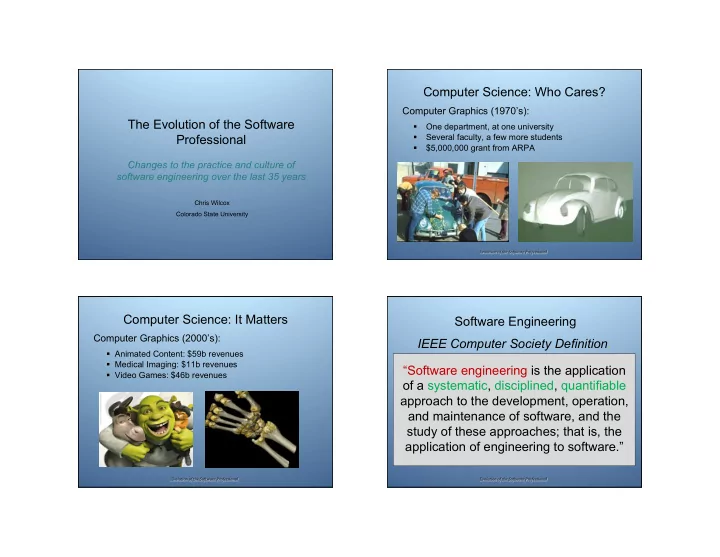

Computer Science: Who Cares? Computer Graphics (1970’s): The Evolution of the Software One department, at one university § Professional § Several faculty, a few more students § $5,000,000 grant from ARPA Changes to the practice and culture of software engineering over the last 35 years Chris Wilcox Colorado State University Evolution ¡of ¡the ¡Software ¡Professional ¡ Computer Science: It Matters Software Engineering Computer Graphics (2000’s): IEEE Computer Society Definition: § Animated Content: $59b revenues § Medical Imaging: $11b revenues “Software engineering is the application § Video Games: $46b revenues of a systematic, disciplined, quantifiable approach to the development, operation, and maintenance of software, and the study of these approaches; that is, the application of engineering to software.” Evolution ¡of ¡the ¡Software ¡Professional ¡ Evolution ¡of ¡the ¡Software ¡Professional ¡ 1
Game Changers in Our Profession Game Changers in Our Profession #1) The fast and ubiquitous access to the #2) The evolution of fast, powerful, inexpensive, accumulated knowledge of humanity: yet reliable hardware and software systems. § Internet Infrastructure, Internet Content § 1978: Intel, 8086, 16-bit, 10 Mhz, 29K transistors § Cisco thinks 8.7 billion in 2012 § 2014: nVidia Tegra, 64-bit, 2.5 Ghz, 1G transistors Evolution ¡of ¡the ¡Software ¡Professional ¡ Evolution ¡of ¡the ¡Software ¡Professional ¡ Game Changers in Our Profession Game Changers in Our Profession #3) Object Oriented Programming #4) Evolving Development Environments § 1978: Fortran, Pascal, Cobol, C becoming popular § 1978: Card Reader, VT100 Terminal, Vi or Emacs § 2014: Ada, C++, Java, Python, Perl, etc. § 2014: DevStudio, Eclipse, GitHub, Amazon Cloud Evolution ¡of ¡the ¡Software ¡Professional ¡ Evolution ¡of ¡the ¡Software ¡Professional ¡ 2
Game Changers in Our Profession Digital Magic #5) Software Engineering Advances #6) Other advances in technology: § 1978: Waterfall Model, Source Control (maybe!) § Transistors (Small, Cheap, Fast Electronics) § 2014: Agile Practices, Test Driven Development § Lasers (Optical Media) § Charge-Coupled Devices (Digital Imaging) § Flat Panel Displays (Awesome Output) § Fiber Optics (Lightspeed Communications) § Flash Memory (Portable Data) § Mobile Communications (1G/2G/3G/4G/5G) Evolution ¡of ¡the ¡Software ¡Professional ¡ Evolution ¡of ¡the ¡Software ¡Professional ¡ Digital Magic Success Factors in this Profession § You must know programming, #6) Other advances in technology: operating systems, software § 1940’s: Transistors (Small, Cheap, Fast Electronics) engineering, etc. § 1950’s: Lasers (Optical Media) § In addition, you must develop § 1960’s: Charge-Coupled Devices (Digital Imaging) expertise that is specific to the § 1960’s: Flat Panel Displays (Awesome Output) domain in which you work § 1970’s: Fiber Optics (Lightspeed Communications) § You must be able to communicate § 1980’s: Flash Memory (Portable Data) your own ideas and understand § 1980’s: Mobile Communications (1G/2G/3G/4G/5G) those of others. § You must have the ability to change and evolve along with technology. Evolution ¡of ¡the ¡Software ¡Professional ¡ Evolution ¡of ¡the ¡Software ¡Professional ¡ 3
Inevitability of Change Evolution ¡of ¡the ¡Software ¡Professional ¡ 4
Recommend
More recommend